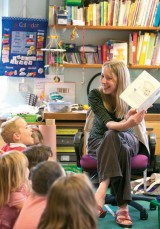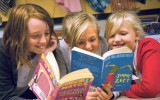If you want children to write effectively about books they have read, you need to give them a good reason to do so, suggests Helen Mulley
What is the point of a book review? As with any creative endeavour, the answer rather depends on the context; for example, my brief for this magazine is to select outstanding titles for primary aged children, and then explain to educators why they are worth promoting to their pupils. I know what I’m supposed to be doing, why, and for whom – and as a result, I find the task immensely satisfying.
 It may not be quite as easy to identify such a clear purpose of ‘the book review’ for a class of developing readers with very mixed abilities – but if you don’t, you risk the activity being of little value at best, and counter-productive at worst. To a child who already enjoys losing himself in a story, an instruction to write about the one he’s just finished can seem like an irritating obstacle, preventing him from picking up the next. And for the youngster who finds the act of reading itself a challenge, tagging a tricky (and apparently pointless) writing exercise onto the process is hardly likely to make it more appealing.
It may not be quite as easy to identify such a clear purpose of ‘the book review’ for a class of developing readers with very mixed abilities – but if you don’t, you risk the activity being of little value at best, and counter-productive at worst. To a child who already enjoys losing himself in a story, an instruction to write about the one he’s just finished can seem like an irritating obstacle, preventing him from picking up the next. And for the youngster who finds the act of reading itself a challenge, tagging a tricky (and apparently pointless) writing exercise onto the process is hardly likely to make it more appealing.
A review shouldn’t be used simply as a way of checking whether or not a book has ctually been read; there are more constructive and effective ways of assessing both compliance and comprehension. Introduced with a little imagination and passion, however, the book review can and should be something that genuinely enhances children’s reading experience, encouraging them to delve deeper into the text and make a much stronger emotional connection with (and investment in) the story. At the same time, it offers students a useful and relatively safe opportunity to flex their critical muscles and begin to understand how to support an instinctive opinion (which cannot be branded as ‘right’ or ‘wrong’) with textual evidence (“Yes, Luke – I understand that you were ‘well bored’; so, what do you think the author should have done differently, to keep your interest?”)
Try this three-step plan to turn your class into active and enthusiastic reviewers:
1. Collect a range of reviews of children’s books from various sources (literary magazines; online retailers and clubs; blogs etc). Read them together with your class, looking for similarities and points of difference. Which are the most interesting, and why? Which make the children want to read the book described, oravoid it? Could you collectively put together a list of characteristics of ‘good’ and ‘bad’ reviews?
2. Explain to the class that you have been asked to come up with some reading recommendations foryounger children. Ask for suggestions, encouraging pupils to explain their choices. Using group discussion and the whiteboard, pick the most popular book, and put together a communal review. Arrange for pupils to present this to a reception group (or perhaps even pay a visit to a feeder preschool setting), encouraging feedback from the audience.
3. Eventually, pupils will be ready to write a personal review of a book of their choice, keeping these questions in mind (have them clearly displayed in the classroom):
• Where will your review be published? If it’s a blog, you can afford to be quite lengthy and flowery. If it’s for the school magazine, however, you might need to be considerably more focused.
• Why did the author write this book? What is she trying to achieve? Does she want tomake you laugh? Cry? Think? All of the above? • How does the author attempt to achieve her goals?What kind of language has she chosen? Is she writing in her own voice, or someone else’s – and does that voice sound ‘real’? What are the characters like? How does she keep you interested in the plot?
• Has the author succeeded in her aims? How did the book make you feel?
• Would you recommend this book to your friends? Why/why not?
• Is there any way you think it could have been better?
 Keep children’s interest bubbling with these activities that give the traditional review a new twist or two…
Keep children’s interest bubbling with these activities that give the traditional review a new twist or two…
• Write a review as if it were the trailer for an action movie – making it as exciting as possible… but without inventing anything!
• Create a ‘word picture’ review; collect words and short phrases that really express how the book made you feel, or sum up the characters and plot. Write them on unlined paper, using different colours and styles of lettering, then cut them out and stick them on coloured card around an image of the book cover (you can find these online, or scan the book directly) to make a piece of artwork that captures your response to what you’ve read.
• Take a look at some popular websites that allow readers to post their own reviews (guardian.co.uk/childrens-books-site,
amazon.co.uk, whsmith.co.uk).
• Find some of your favourite books, as well as at least one you’ve disliked, and see what other people have said about them. Pick out statements with which you agree and disagree. Look at reviews for books you don’t know – which make you want to go and read them, and why? Finally, add your own review.
• Write a review expressing the opposite opinion from your real one.
 Looking for a specific reviewing challenge for your class? how about getting them to come up with some copy for teach primary?
Looking for a specific reviewing challenge for your class? how about getting them to come up with some copy for teach primary?
Conveying a lot of information using a limited number of words is an essential skill when writing for magazines. It can also be an extremely useful exercise for the classroom; forcing pupils to be absolutely clear about the key points they are trying to make, and to select every word with care.
From next issue, we’ll be including an outstanding children’s book review in every edition of Teach Primary. As well as the surely priceless) thrill of seeing his or her work gracing the pages of such a prestigious magazine, published writers will receive a children’s book bundle from Bloomsbury worth £80.
Reviews can be about any title, fiction or non-fiction, but must be no more than 150 words long. They should be typed by pupils, and emailed to .(JavaScript must be enabled to view this email address), with ‘book club’ as the subject (alternatively, handwritten reviews can be posted to Teach Primary Book Club, 25 Phoenix Court, Hawkins Road, Colchester, Essex, CO2 8JY). Please make sure to include the book’s title and author, and the full name and age of the reviewer (ideally attaching an image, too), along with the school attended.
Oh, and to avoid a Giles Coren-esque tantrum upon the arrival of the magazine, it’s probably worth letting your students know that their work may be subject to minor editorial amendments before it appears in print – but you can reassure them any tinkering will most definitely not be just for the sake of it…”
If your marking doesn’t affect pupil progress - stop it!
Ace-Classroom-Support
KS2 Lesson plan: China and Buddism
Ace-English
How Financial Education Helps Children
Ace-Classroom-Support
Make World Book Day Extra Special This Year
Ace-English
